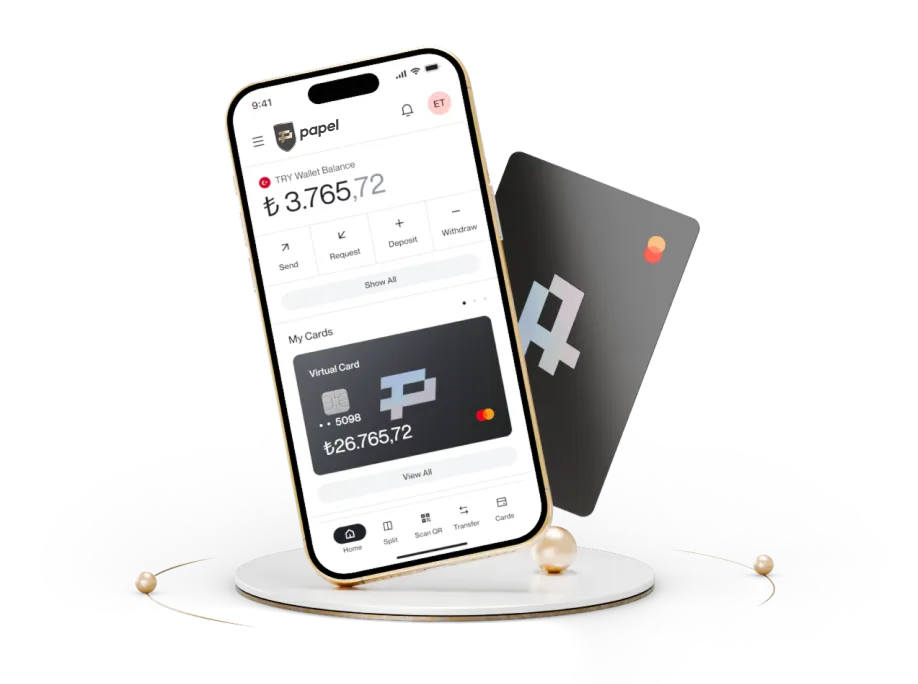API Banking: What Is It?
In today's digital age, where financial technologies are rapidly evolving, the banking sector is transforming through innovative systems like API banking and open banking. API banking allows banks to securely and controllably share their services via financial APIs with third-party providers, such as fintech companies. Banks achieve real-time financial integration through API connections, while fintechs offer personalized financial services through API solutions. So, what is API banking, how does it work, how does it differ from open banking, and in which areas is it applied? Papel Blog answers these questions for you.
What is API banking?
API (Application Programming Interface) banking involves banks using APIs to open their services and data to third-party developers. With the customer's consent, this system enables banks to share customer data and transactions with third-party service providers, like fintech companies. In Turkey, open banking practices are regulated by the Central Bank of the Republic of Turkey (CBRT). Since the regulation was enacted on March 15, 2020, banks are officially authorized to collaborate with fintechs by opening their APIs.
How does it differ from open banking?
Open banking and API banking are closely related concepts forming the foundation of modern financial services, yet they have significant differences. Open banking, as an application area of API banking, refers to banks sharing customer data with third-party service providers with the customer's consent. This system allows customers to benefit from more personalized financial services. For instance, a customer using open banking services can view account information from different banks through a single application or perform payment transactions via this application.
API banking, on the other hand, refers to banks opening their services to third parties via APIs. While APIs provide the technological infrastructure, open banking systems, which require explicit customer consent, are supported by legal regulations like PSD2. Moreover, open banking has a wide range of applications using API technology. In summary, API banking enables banks to share their technological infrastructure with third parties, while open banking uses it to share and manage customer data. Despite their differences, these two concepts are interconnected and crucial for digitalizing financial services and the proliferation of personalized financial services.
How does API banking work?
API banking enhances user experience by enabling real-time data flow and swift transaction processing. The API system operates as follows:
In the API banking system, banks typically access developers through an API portal, where developers can review necessary documentation and develop their integrations in test environments to initiate the process.
Once integration is complete, third-party applications can access the bank's services with the user's explicit consent and offer them through their platforms. This allows users to monitor account information from different banks via a single application, perform payment transactions like EFT and wire transfers directly through third-party applications, apply for credit or debit cards, and access their financial data in real time.
In Turkey, with the regulation enacted on March 15, 2020, open banking services have been legally established, and banks are officially authorized to collaborate with fintech companies via APIs. Additionally, open banking systems are supervised by the Central Bank of the Republic of Turkey. In open banking systems, which share user data with explicit consent, user consent must be obtained digitally for a specified period. Sharing data without customer consent is prohibited, and data flow is secured through advanced authentication methods and encryption technologies.

API collaboration between banks and fintech
API banking significantly benefits the digitalization of financial services by strengthening collaborations between banks and fintech companies. The partnership between banks and fintechs allows fintech companies to develop innovative solutions through the APIs provided by banks. APIs enable fintech companies to integrate with banks' infrastructures and offer various financial services to their users. The advantages of API collaboration can be summarized as follows:
- For fintech companies: APIs provided by banks offer fintech companies the opportunity to develop financial products and services, allowing them to enter the market more quickly and expand their customer base.
- For banks: Collaborating with fintech companies accelerates banks' digital transformation processes and enhances customer satisfaction.
- For customers: API collaborations between banks and fintech companies enable customers to access personalized financial services more quickly and easily.
The role of TPP (Third Party Provider)
Third-party providers (TPPs), which play a significant role in open banking systems, access customers' financial data with explicit consent and use it to offer personalized financial services. By providing these services, TPPs increase competition and are generally divided into two main categories:
Account Information Service Providers (AISP): AISPs collect customers' information from different banks and present this data to users on a single platform, making it easier to manage their financial situations.
Payment Initiation Service Providers (PISP): PISPs enable users to make payments directly from their bank accounts. This method, an alternative to traditional card systems, allows faster payments.
Application areas of API banking
Developed within the open banking framework, API banking facilitates the digitalization of financial services, making financial transactions faster, more secure, and user-friendly. By strengthening the collaboration between banks and fintech companies, API banking contributes to customer experience and serves two main applications:
Payment Initiation Service (PIS) via API
Payment Initiation Service (PIS) is a service that allows users to make payments directly from their bank accounts through a third-party application. PIS, which enables users to make quick and secure payments without leaving the platform they are shopping on, is included among open banking services in Turkey under Law No. 6493 on Payment and Securities Settlement Systems, Payment Services, and Electronic Money Institutions.
Account Information Service (AIS)
Account Information Service (AIS) is a service that allows users to view their account information from different banks collectively on a single platform. AIS, which enables users to manage their financial situations more effectively, allows secure access to economic data from different bank accounts with the customer's explicit consent and presents this data in one place. This makes it easier for users to track their spending and manage their financial situations. Additionally, this system allows users to receive personalized financial advice and product recommendations.
The information provided in this blog post is for general informational purposes only and does not constitute legal, financial, or investment advice. The content is prepared for informational purposes, and seeking professional advice for your specific circumstances is recommended. The statements in the article are not binding or liable and reflect only the author's evaluations. All decisions you make are your responsibility, and Papel Elektronik Para ve Ödeme Hizmetleri A.Ş. does not accept any liability in this context.

